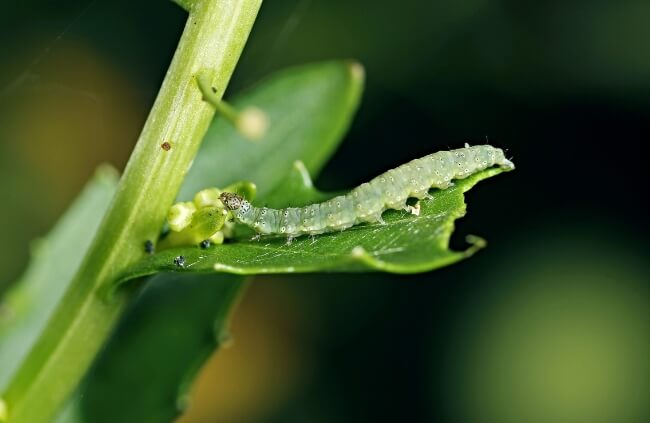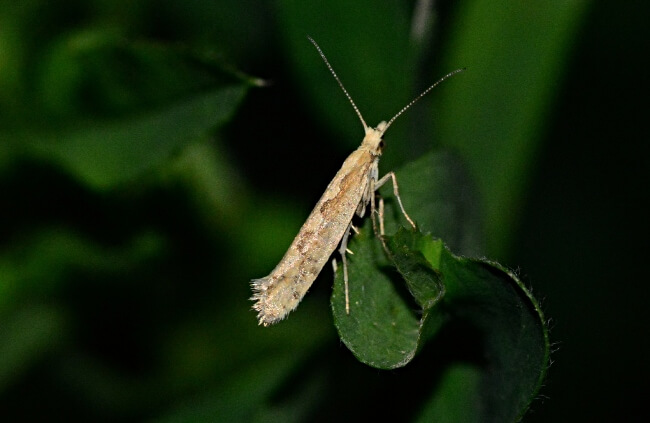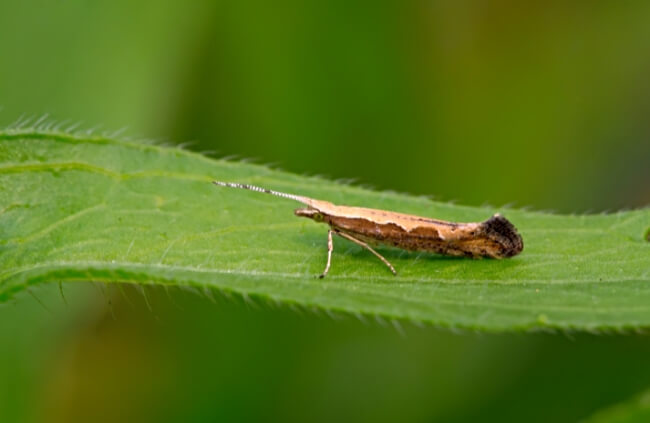The diamondback moth can be a real pain in the patch! It is a notorious pest in Australian veggie gardens, especially gardens growing brassicas like cabbage, broccoli, cauliflower, kale and more.
I’ve heard from so many of my fellow gardeners recently about how diamondback moths are wreaking havoc in their veggie patches so in today’s article, I’m going to explain how you can deal with these pesky invaders.
More...
Family: | Plutellidae |
|---|---|
Genus: | Plutella |
Species: | P. xylostella |
Common name: | Diamondback moth |
Type: | Moth |
Size: | Adult (15-20 mm wingspan) Caterpillar (10-12 mm long) |
Key Features: | Narrow, fringed wings with a slender body |
Colour: | Greyish brown slender body and wings with brown markings |
Effects: | Attack and burrow into the inner leaves of brassicas |
Prevention: | Crop rotation, netting, beneficial insects, garden hygiene, organic pesticides |
The diamondback moth is a common and destructive pest in Australian gardens, particularly in vegetable patches. Understanding this pest and learning how to control it is crucial for maintaining healthy and productive crops.

What are Diamondback moths?
Diamondback moths, scientifically known as Plutella xylostella, are small, greyish-brown moths that are notorious for targeting cruciferous vegetables. These insects originated in Europe but have spread worldwide, including Australia..
Natural Habitat of Plutella xylostella
Diamondback moths thrive in temperate regions, making Australia's varied climates ideal for their proliferation. They prefer areas where cruciferous plants (like cabbages, broccoli, and cauliflower) are abundant, as these plants provide both food and breeding grounds for the moths.
Diamondback Moths' Life Cycle
The life cycle of the diamondback moth is quite rapid, allowing it to produce multiple generations within a single growing season. The cycle begins when the female moth lays her eggs on the underside of leaves.
These eggs hatch into larvae, commonly known as diamondback moth caterpillars, which feed voraciously on the host plant. After a period of feeding, the caterpillars pupate and eventually emerge as adult moths, ready to start the cycle again.
In Australia, this cycle can occur every 2-3 weeks during the warmer months.
Plants the Diamondback Moth Attacks in Australia
In Australia, diamondback moths primarily target brassicas (cruciferous vegetables), which include cabbages, broccoli, cauliflower, Brussels sprouts, and kale. However, they may also attack other leafy greens like lettuce and spinach, especially when their preferred plants are scarce.
How to Identify Diamondback Moths
Identifying diamondback moths at various stages of their life cycle is crucial for effective control. The sooner you spot them, the better your chances of preventing significant damage.
Eggs
Diamondback moth eggs are tiny, oval, and yellowish-white. They are typically laid in clusters on the underside of leaves, making them difficult to spot without careful inspection. Regularly checking the underside of leaves is essential for early detection.
Caterpillar

The diamondback moth caterpillar is the most destructive stage of the insect’s life cycle. These caterpillars are small, green, and slender with a slight tapering at both ends. They may have faint white stripes running lengthwise down their bodies. Caterpillars are often found feeding on the outer leaves of plants but can also burrow into the heads of cabbages and other vegetables, making them hard to detect.
Moth
Adult diamondback moths are small, greyish-brown, and have a wingspan of about 15-20 mm. They have distinctive narrow wings with fringed edges, and when at rest, their wings fold back along the body, giving them a slender appearance. Their wings may also feature a diamond pattern.
The moths are most active during the evening and nighttime, although they can sometimes be seen during the day.


Get Your Free Guide:
Master Growing Australian Natives eBook
A Must Have Complete Guide for Every Australian Garden
Get Your Free Guide:
Master Growing Australian Natives eBook
A Must Have Complete Guide for Every Australian Garden
Where You Can Find Diamondback moths on Plants
Diamondback moths and their larvae can be found on the undersides of leaves, within the folds of developing cabbage heads, or near the base of the plant where the stem meets the soil. Caterpillars may also hide in the soil during the day to avoid predators, emerging at night to feed.
Signs of Damage to Look For
The most obvious sign of a diamondback moth infestation is the presence of small, irregular holes in the leaves of plants. You may also notice frass (caterpillar droppings) on the leaves, which look like tiny green or brown pellets.
In severe infestations, the caterpillars can skeletonise leaves, leaving only the veins intact. If left unchecked, these pests can quickly destroy entire plants, leading to significant crop loss.
How Quickly Do They Destroy Veggies?
The diamondback moth caterpillar can cause substantial damage in a short period, especially during warm weather when their development is rapid. A small infestation can become severe in just a few days, with caterpillars devouring leaves and burrowing into vegetable heads.
Without intervention, an entire crop can be ruined within a week or two.
What Causes Diamondback Moth Infestations?
Several factors contribute to diamondback moth infestations in Australian gardens:
- Warm Temperatures: Warmer weather accelerates the life cycle of diamondback moths, leading to more frequent generations and larger populations.
- Lack of Natural Predators: In gardens where natural predators like birds, parasitic wasps, and predatory insects are scarce, diamondback moth populations can grow unchecked.
- Overcrowded Planting: Dense plantings can create a humid environment that favours diamondback moths and makes it easier for them to move between plants.
- Poor Garden Hygiene: Debris and leftover plant material can harbour diamondback moth eggs and larvae, leading to recurring infestations.
How to Prevent Diamondback Moth Infestations

Preventing diamondback moth infestations is key to protecting your vegetable garden. Here are some practical gardening tips:
- Crop Rotation: Regularly rotate crops to disrupt the life cycle of diamondback moths. Avoid planting the same cruciferous vegetables in the same spot year after year.
- Netting: Use fine mesh or insect netting to physically block moths from laying eggs on your plants. Ensure the netting is securely fastened to prevent moths from entering.
- Companion Planting: Grow plants that repel diamondback moths, such as mint, thyme, or dill, near your vulnerable crops. These plants can mask the scent of cruciferous vegetables, making them less attractive to moths.
- Encourage Beneficial Insects: Attract natural predators like ladybirds, lacewings, and parasitic wasps to your garden by planting nectar-rich flowers. These insects can help control diamondback moth populations.
- Garden Hygiene: Keep your garden clean and free of debris. Remove old leaves, plant stems, and other garden waste that can harbour pests.
How to Get Rid of Diamondback Moths
If an infestation occurs, there are several organic and practical methods to get rid of diamondback moths:
- Handpicking: Regularly inspect your plants and remove any visible caterpillars, eggs, or moths by hand. This method is time-consuming but effective for small infestations. Just be sure to wear protective gardening gloves!
- Neem Oil: Apply neem oil, a natural insecticide, to your plants. Neem oil disrupts the feeding and development of caterpillars, reducing their numbers over time. Ensure thorough coverage, especially on the undersides of leaves.
- Bacillus thuringiensis (Bt): Bacillus thuringiensis is a naturally occurring bacterium that targets caterpillars while being harmless to humans, pets, and beneficial insects. It is available in powder or spray form and should be applied to plants at the first sign of caterpillars.
- Biological Controls: Introduce parasitic wasps or predatory insects like lacewings into your garden. These natural enemies of diamondback moths can help keep populations in check.
- Traps: Yellow sticky traps can be used to capture adult moths, reducing the number of eggs laid on your plants. These traps should be placed around the perimeter of your garden and checked regularly.
Diamondback Moth FAQs

Can diamondback moths survive through the winter in Australia?
Yes, diamondback moths can survive mild Australian winters, especially in warmer regions. The adult moths may overwinter in sheltered areas, or the pupae can remain dormant in the soil until conditions improve.
Are there any non-organic methods to control diamondback moths?
While chemical insecticides are available, they are generally discouraged in home gardens due to potential harm to beneficial insects, pets, and humans. Organic methods are safer and equally effective when used correctly.
How often should I check my garden for diamondback moths?
It's advisable to inspect your garden at least once a week during the growing season. More frequent checks may be necessary during peak periods of moth activity, particularly in warmer weather.
Can diamondback moths affect other types of plants?
While diamondback moths prefer cruciferous vegetables, they can occasionally attack other leafy greens. However, their impact on non-cruciferous plants is usually minimal.
Now You Know How to Deal with Diamondback Moths
The diamondback moth is a persistent pest in Australian gardens, but with proper identification, prevention, and control measures, you can protect your vegetable crops from serious damage.
By maintaining good garden hygiene, employing organic control methods, and encouraging natural predators, you can keep these pests at bay and enjoy bountiful harvests!
Published on September 30, 2025 by Gary Clarke
Last Updated on September 30, 2025




